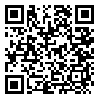Volume 20, Issue 1 (2020)
MCEJ 2020, 20(1): 147-159 |
Back to browse issues page
Download citation:
BibTeX | RIS | EndNote | Medlars | ProCite | Reference Manager | RefWorks
Send citation to:



BibTeX | RIS | EndNote | Medlars | ProCite | Reference Manager | RefWorks
Send citation to:
Malekipoor E, Emami E, Moshrefyfar M, Ajalloeian R. Investigation of the process of water leakage using discrete fracture network method (Case Study: Gardaneh rokh tunnel). MCEJ 2020; 20 (1) :147-159
URL: http://mcej.modares.ac.ir/article-16-29367-en.html
URL: http://mcej.modares.ac.ir/article-16-29367-en.html
1- yazd university
2- yazd university ,en.emami@yazd.ac.ir
3- Esfahan university
2- yazd university ,
3- Esfahan university
Abstract: (4111 Views)
Undoubtedly, fluid flow modeling plays an important role in underground structures studies. In many cases, the main system for fluid flow in rock mass is the fractures network. Because of that the measurement of the geometric properties of the discontinuities is a time-consuming process and for some properties like persistence is impossible, the use of stochastic modeling for rock mass is suggested. Uncertainty about the geometric properties of discontinuities has led to use of statistical analysis for more accurately define geometric features. Because of intrinsic statistical nature of the geometric features of discontinuities, a more precise model can be obtained from the development of stochastic three-dimensional geometric models of discontinuities. The most important step in rock mass modeling is the exact definition of the discontinuity network. This makes it possible to provide a better starting point for numerical modeling in mechanical and hydraulic analysis. The Gardaneh-Rokh tunnel with a length of 1300 meters and a maximum volume of 200 meters is located in Chaharmahal Bakhtiary province. The purpose of this study was to investigate the water leakage from joints and fractures in the tunnel and the effect of surface water in the amount of water leakage into the tunnel using analytical and numerical methods. This modeling has been done to increase the understanding of the hydraulic behavior of the massive discontinuity system. In this study, the fractures connected to each other as the main paths of water flow into the tunnel and the control of the hydraulic behavior of the mass are assumed, and the roughness of the joints is neglected To this paper, joint sets in Gagrdaneh Rokh tunnel was modeled using the 3D-DFN code written in the Mathemtica software, after validation of the surveyed and modeled values, it was observed that the percentage of conformance is above 85%. This has led to the use of model outputs with confidence in the hydraulic modeling of the tunnel. This paper is designed with the aim of two-dimensional hydraulic modeling in the UDEC software environment. The modeling fluid is considered as monophasic, and discontinuities are modeled as two-dimensional. Hydraulic modeling is done by calling the joints from the 3D-DFN program output. Comparison of the obtained results shows good matching between the flow rate in the model with the actual flow rate. The resulting total flow rate is estimated to be 362 liters per minute, which is actually set at 375 liters per minute, which is a good match. Also, the sensitivity analysis of fluid flow has been investigated with respect to the maximum and minimum values of apertures, continuity (trace length) and Fisher numbers. With an opening of 5 mm, the water rate to the tunnel will reach 530 liters per minute. This rate is reduced to 172 liters per minute at opening of 1.2mm. The flow rate arrives in continuity of 27 meters to 523 liters per minute, in a trace length of 22 meters to 488 liters per minute and in trace length of 10 meters to 354 liters per minute. The flow rate in Fisher's number is reduced to 410 liters per minute and in Fisher's number 25 to 290 liters per minute.
Article Type: Original Research |
Subject:
Hydraulical Structures
Received: 2019/01/13 | Accepted: 2019/12/31 | Published: 2020/04/29
Received: 2019/01/13 | Accepted: 2019/12/31 | Published: 2020/04/29
Send email to the article author
| Rights and permissions | |
 |
This work is licensed under a Creative Commons Attribution-NonCommercial 4.0 International License. |








